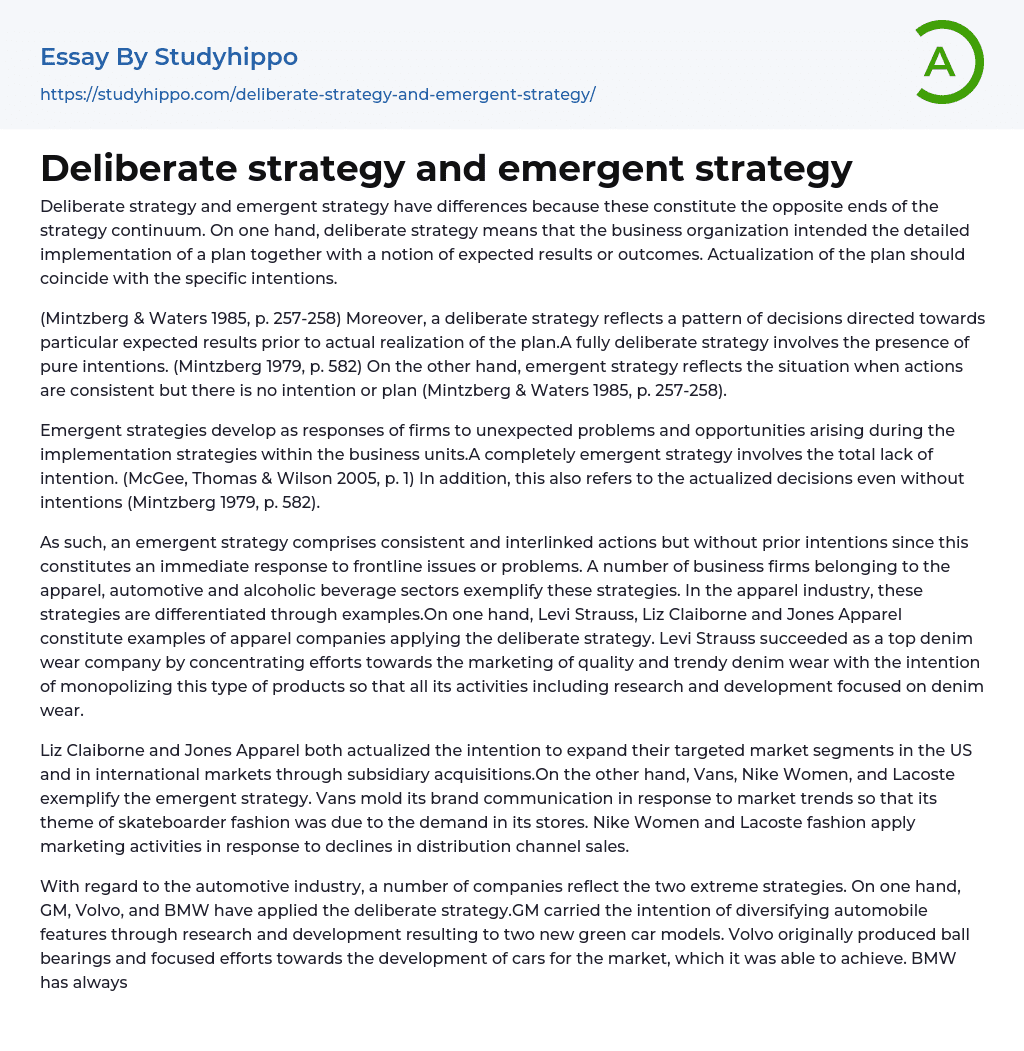Deliberate strategy and emergent strategy have differences because these constitute the opposite ends of the strategy continuum. On one hand, deliberate strategy means that the business organization intended the detailed implementation of a plan together with a notion of expected results or outcomes. Actualization of the plan should coincide with the specific intentions.
(Mintzberg & Waters 1985, p. 257-258) Moreover, a deliberate strategy reflects a pattern of decisions directed towards particular expected results prior to actual realization of the plan.A fully deliberate strategy involves the presence of pure intentions. (Mintzberg 1979, p. 582) On the other hand, emergent strategy reflects the situation when actions are consistent but there is no intention or plan (Mintzberg & Waters 1985, p. 257-258).
Emergent strategies develop as responses of firms to unexpected problems and opportunities arising during the implementation strat
...egies within the business units.A completely emergent strategy involves the total lack of intention. (McGee, Thomas & Wilson 2005, p. 1) In addition, this also refers to the actualized decisions even without intentions (Mintzberg 1979, p. 582).
As such, an emergent strategy comprises consistent and interlinked actions but without prior intentions since this constitutes an immediate response to frontline issues or problems. A number of business firms belonging to the apparel, automotive and alcoholic beverage sectors exemplify these strategies. In the apparel industry, these strategies are differentiated through examples.On one hand, Levi Strauss, Liz Claiborne and Jones Apparel constitute examples of apparel companies applying the deliberate strategy. Levi Strauss succeeded as a top denim wear company by concentrating efforts towards the marketing of quality and trendy denim wear with the intention of monopolizing this type of products so that all
its activities including research and development focused on denim wear.
Liz Claiborne and Jones Apparel both actualized the intention to expand their targeted market segments in the US and in international markets through subsidiary acquisitions.On the other hand, Vans, Nike Women, and Lacoste exemplify the emergent strategy. Vans mold its brand communication in response to market trends so that its theme of skateboarder fashion was due to the demand in its stores. Nike Women and Lacoste fashion apply marketing activities in response to declines in distribution channel sales.
With regard to the automotive industry, a number of companies reflect the two extreme strategies. On one hand, GM, Volvo, and BMW have applied the deliberate strategy.GM carried the intention of diversifying automobile features through research and development resulting to two new green car models. Volvo originally produced ball bearings and focused efforts towards the development of cars for the market, which it was able to achieve. BMW has always maintained its intention of gaining majority of the market for luxury cars. On the other hand, Honda, Ford and Mitsubishi exemplify the application of the emergent strategy.
Honda had not intended the extent of its internationalization indicating the lack of intention for its current achievements.Ford re-organizes its leadership in response to decreasing sales. Mitsubishi re-introduced its brand in response to claims of defects in their cars a number of years ago. In relation to the alcoholic beverages industry, firms represent the two strategies. On one hand, Suntory Limited, LVMH and Diageo exemplified the deliberate strategy. Suntory intended and achieved top position through its premium brands.
LVMH successfully merged luxury clothing and alcoholic beverage brands under a single
company.Diageo achieved organic growth by focusing on market expansion and product diversification. On the other hand, Miller, Anheuser-Busch and Bass plc exemplify the emergent strategy. Miller and Anheuser-Busch took advantage of the popularity of energy drinks by introducing alcoholic products mixed with energy boosting components and ended up appealing to the younger market even without the explicit intention to do so. Bass plc responded to changes in demand and relying on existing local distribution chains and eventually achieve a top position.
- Wal-Mart essays
- Discover essays
- Renault essays
- Truck essays
- chrysler essays
- The city essays
- Racing essays
- Competition essays
- Effective Leadership essays
- Leadership Styles essays
- Public relations essays
- Planning essays
- Mission Statement essays
- Outsourcing essays
- Swot Analysis essays
- Business Analysis essays
- Business Plan essays
- Strategic Management essays
- Strategic Planning essays
- Reasoning essays
- Community Development essays
- Negotiation essays
- Advertisement essays
- Advertising essays
- Anheuser-busch essays
- Audience Theory essays
- Brand essays
- Brands essays
- Competitor Analysis essays
- Consumer essays
- Detergent essays
- Marketing Management essays
- Marketing Mix essays
- Marketing Plan essays
- Marketing Research essays
- Marketing Strategy essays
- New Product Development essays
- Point Of Sale essays
- Price essays
- Procurement essays
- Product essays
- Product Differentiation essays
- Product Placement essays
- Promotion essays
- Promotion And Marketing Communications essays
- Research Design essays
- Retailing essays
- Trademark essays
- Bicycle essays
- Cars essays




